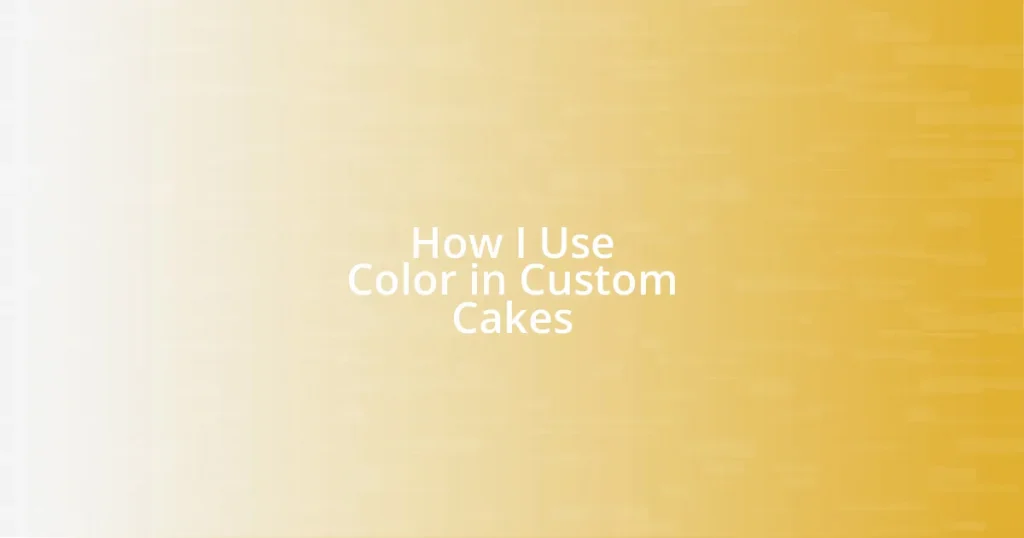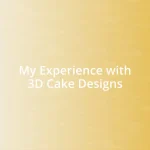Key takeaways:
- Color theory and psychology play vital roles in cake design, influencing emotions and aesthetics.
- Choosing the right color palette enhances the theme and occasion of custom cakes, utilizing seasonal and trendy colors.
- Techniques like airbrushing, edible paints, and colored fondant shapes contribute to the visual impact and personalization of cakes.
- Maintaining color consistency is crucial, achieved through high-quality gel food coloring, careful measurement, and test batches.

Understanding Color Theory Basics
Color theory is a fascinating concept that explains how different colors interact with one another and evoke emotions. For example, when I started experimenting with cake designs, I realized that warm colors like red and orange sparked excitement and energy, while cooler shades like blue and green impart a sense of calmness. Have you ever noticed how certain colors can immediately change the mood of a space? The right color choices can transform an ordinary cake into a stunning centerpiece.
One important aspect of color theory is understanding the color wheel. This tool outlines the relationship between primary, secondary, and tertiary colors. I remember the first time I tried creating a gradient effect on a cake—using complementary colors made my design pop beautifully. It’s surprising how simply knowing the color wheel can enrich your creations. With just a glance, you can see which colors will harmonize or clash, helping elevate your cake art to a new level.
Another critical element is the psychology of color. Different colors can elicit specific feelings; for instance, yellow often represents happiness, while purple may evoke a sense of luxury. When I choose colors for a custom cake, I ask myself, “What story do I want to tell?” This reflection helps me select the right shades that resonate with the occasion and my client’s vision. It’s like creating an emotional experience through flavors and colors, and that’s something truly magical.

Choosing the Right Color Palette
Choosing the right color palette is essential in creating custom cakes that truly resonate with a theme or occasion. I often start by thinking about the event type. For instance, pastel colors are a popular choice for baby showers, while vibrant hues work well for birthdays. Recently, I made a cake for a wedding, and selecting a soft blush pink and gold combination not only suited the decor but also brought a romantic vibe to the celebration.
Incorporating seasonal colors can also add a special touch. During fall, I love using warm tones like burnt orange and deep red, evoking the cozy, rich feelings of the season. I recall a Thanksgiving cake where I experimented with earthy tones that mirrored the autumn landscape outside. It was incredible to see how those colors created a warm and inviting atmosphere, making the cake not just a dessert but a beloved part of the gathering.
Sometimes, it’s fun to think outside the box. Trendy color combinations often catch my eye, like the rise of teal and copper. I once created a cake for a corporate event themed around innovation, where I paired those colors. The feedback was overwhelming! People were so drawn to the unexpected yet pleasing aesthetic. It’s experiences like this that remind me how beneficial it can be to try new combinations when choosing colors for custom cakes.
| Color Palette | Occasion |
|---|---|
| Pastels | Baby Shower |
| Warm Tones | Fall Events |
| Blush Pink & Gold | Weddings |
| Teal & Copper | Corporate Events |

Incorporating Colors into Cake Design
When it comes to incorporating colors into cake design, I often think about how layering can enhance the overall look. For instance, I love using vibrant colors for the cake layers to create a stunning surprise as you slice into the cake. I once made a rainbow layer cake, and the joy on my clients’ faces when they saw those bright layers peek through was incredibly rewarding. It’s those moments that remind me how powerful color can be in evoking happiness.
- Use vibrant layers for surprise effects.
- Consider using ombre techniques for a smooth transition between colors.
- Add edible flowers in colors that complement the cake’s palette.
- Experiment with metallic accents for a touch of elegance.
- Incorporate colored drips or sprinkles for playful elements.
I’ve also discovered that texture can play a crucial role in how color is perceived in cake design. Recently, I created a cake with a marbled fondant finish—the blend of lavender and deep purple not only looked beautiful but also brought depth. That tactile aspect elevated the visual appeal, inspiring guests to interact with the cake even before tasting it. It’s fascinating to see how combining colors with different textures can create a captivating cake that draws everyone in.

Techniques for Applying Color
When applying color to cakes, I often turn to airbrushing as a technique that offers both precision and creativity. I remember my first attempt at airbrushing—a stunning ombre effect on a chocolate ganache cake. Watching the colors blend seamlessly together was almost magical! As I learned the proper pressure and distance, I realized how easily this technique could transform a simple cake into a vibrant centerpiece. Have you ever tried airbrushing? If so, what was your experience?
Another method I enjoy is using edible paints, which can add intricate details that really make a cake stand out. For a recent birthday cake, I hand-painted delicate floral patterns in soft pastels that complemented the overall design perfectly. It takes a steady hand and some practice, but the satisfaction I felt as I watched each petal come to life was unmatched. Paint allows for a level of artistry that truly personalizes each creation. What colors would you choose to work with?
Lastly, I often utilize colored fondant shapes as playful accents. For instance, I once crafted bright, whimsical stars and hearts to adorn a cake for a child’s birthday. The joy on the little one’s face was priceless when they saw their favorite colors and shapes come together. It really highlighted for me how these colorful elements can enhance the cake’s personality and evoke delightful emotions. Have you considered using colored fondant in your designs? It can truly elevate the overall aesthetic!

Using Color for Theme Enhancement
Color can truly amplify a cake’s theme, turning a simple dessert into a storytelling centerpiece. For instance, I once created a winter wonderland cake with hues of icy blue and shimmering silver. The moment my client laid eyes on it, I could see them transported to a snowy landscape, which was exactly the emotion I aimed to evoke. Have you ever had a color palette that vividly captured a memory or theme for you?
Additionally, I love how specific colors can resonate with particular themes. For a garden party cake, I chose soft pastels like blush pink and mint green, deploying a sense of whimsy and elegance. Each slice not only looked delightful but also celebrated the spirit of the event, as guests admired the beautifully coordinated colors. I still recall the compliments rolling in as everyone connected the cake to the flowers gracing the tables.
On another occasion, I crafted a superhero-themed cake, layering bold reds and yellows. The vibrant colors screamed energy and excitement, perfectly matching the personality of the birthday boy. His expression when he saw the cake was priceless! It struck me how colors could reflect emotions and stories behind every celebration. Don’t you think embracing color in cake design can lead to unforgettable moments?

Tips for Color Consistency
To achieve color consistency, I recommend investing in high-quality gel food coloring. I’ve found that these concentrated colors offer better blendability and stability compared to liquid options. One time, I vividly remember mixing a deep red for a velvet cake; the gel provided just the right hue without watering down the batter. Have you tried using gels? If not, you might be surprised at the difference!
Another tip I always emphasize is to measure your colors carefully. Early in my cake-decorating journey, I often winged it, and I ended up with varying shades, which looked less polished. Now, I keep a color chart handy to note the exact amounts I use for each batch. This practice not only boosts my confidence but also ensures that I can replicate my favorite shades again and again. Isn’t it freeing to know you can recreate a perfect hue?
Lastly, I’ve learned the value of preparing a test batch when experimenting with new color combinations. Once, while prepping for a wedding cake, I mixed several colors for a marbled effect but wanted to make sure I loved it. I baked a small dummy cake and tried it out — what a lifesaver! It allowed me to tweak the colors until they were just right, ensuring the final cake would be exactly as envisioned. Have you ever done a practice run? Trust me, it’s worth every minute!















